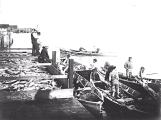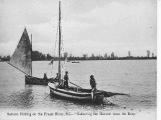15
NATIVE FISHERMEN AT GARRY POINT CANNERYIn the early 1880's Native fishermen were still bringing fish to the canneries in their dugout canoes. When the canneries got their fishing licenses in the late 1880's, they started providing the Native fishermen with flat-bottomed skiffs with pointed bows and sterns. These 20-foot long Fraser River skiffs were equipped with detachable masts and sails but could also be rowed with oars. During the short summer sockeye salmon runs, each boat was used for two 12-hour shifts daily, with a boat "puller" and a fisherman on board. When the fishing season ended, the skiffs were repaired, repainted, and stored at the cannery for the winter.
17
COLUMBIA RIVER BOATSFraser River skiffs were replaced by 25-foot, fixed mast, round-bottomed Columbia River boats in the early 1890's. Some people claim the Columbia River boats were first built in San Francisco for the Sacramento and Columbia River fisheries but similar boats were also being built on Lake Ontario by Captain William Watts who moved west in 1888 to start the Vancouver Shipyard. The two-man crew stayed on board from Sunday night to Saturday morning, sleeping under a canvas pup tent. Steam-powered tugs collected the fish daily. Larger Columbia River boats became known as Bristol Bay boats because they fished in Alaska. The last of these was built in Steveston at David's Boat Works in the early 1950's.
19
CHINESE "SLITTERS" BUTCHERING FISHEach cannery employed about 150 workers to make the cans, gut and clean the salmon, fill, seal, cook, label, and box the cans. Each cannery produced about 1,000 cases of 48 one-pound tins a day, working about 20 days during the short sockeye fishing season. Before 1900 each canning line was a row of water tanks, tables and hand-powered machines. The cannery workers were mainly Native women and Chinese men with a few Caucasian bosses. The fish were carried from station to station in hand trucks. In this picture, Chinese "slitters" are cutting off the heads, tails and fins of the salmon and slashing open the bellies at the start of the canning line. Thousands of fresh fish wait on the floor.
21
NATIVE WOMEN CLEANING SALMONAfter the fish were slit open, Native women removed the guts, scraped off the scales and scrubbed the fish bodies. The waste was washed into the river through holes in the cannery floor. The salmon were carried to Chinese "choppers" who sliced the fish into can-sized steaks using hand-operated gang knives with eight carefully spaced blades. Tubs of these fish pieces were dumped into a raised V-groove in the center of a table between 2 lines of Native women "fillers" who put the pieces into cans arranged in trays. Each filler had a filling case with a rim that fit inside the empty can and an expert filler could fill 12 cans in 4 minutes.
23
CHINESE WORKERS SOLDERING LIDsThis picture shows workers at the Scottish Canadian cannery soldering vent holes after exhausting air from filled cans. Chinese "cappers" put pieces of tin on the fish and put the lids on the cans, making sure that small vent holes in the lids were over the tin pieces. The lids were crimped and soldered firmly in place and the vent holes were soldered shut. Cans were wiped clean with old gillnet mesh then cooked for an hour in tanks heated by steam pipes. Holes were punched in the lids to release steam then again soldered shut. Another hour of cooking at 240 degrees Fahrenheit followed. Finally, cans were checked for leaks, washed, cooled, and stacked. At the end of the canning season, the cans were labeled and packed in wooden boxes for shipping.
25
NATIVE HOUSING AT STAR CANNERYCanneries provided housing for their Native fishermen and women cannery workers. This originally consisted of rows of one-room units like the traditional longhouses with bulrush mats for doors, earthen floors and no windows. Each room had a fire in the center for cooking and warmth, and a hole in the roof for smoke to escape. There were also smokehouses to cure the salmon and eulachons. There were 3 sets of these housing units in 1895 but most had disappeared by 1911 as Japanese wives replaced the Native women in the canneries and Natives moved to canneries farther north.
27
JAPANESE LIVING QUARTERSManzo Nagano, the first Japanese fisherman in B.C., arrived in New Westminster in 1877. Gihei Kuno came to Steveston from the village of Mio Mura in Wakayama prefecture in 1887 and is credited with beginning a large migration of Japanese to Steveston. The first Japanese boat builder, Kyuzo Kawamura, worked for the Phoenix cannery in the late 1880's. In 1896 there were about 1300 Japanese men and fewer than 15 Japanese women in Steveston. They lived in cannery housing like that shown here near the Scottish Canadian cannery at the west end of Garry Point. The cannery operated from 1899 to 1912 but the cannery houses were occupied until 1942.






